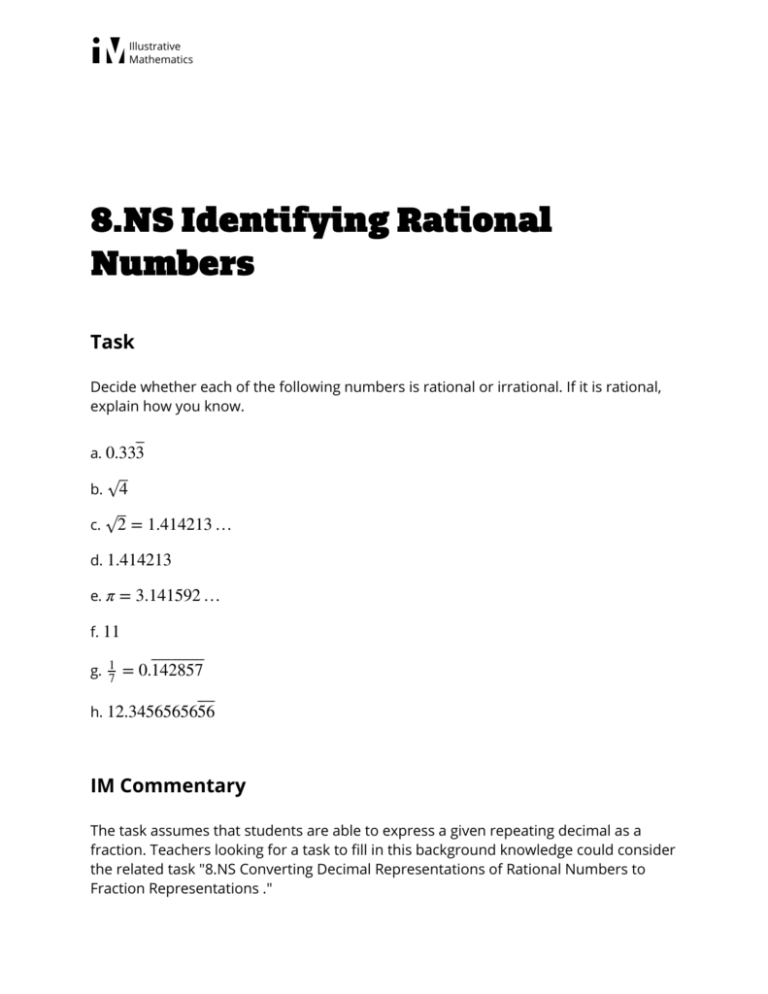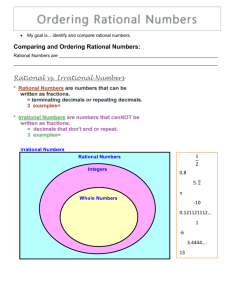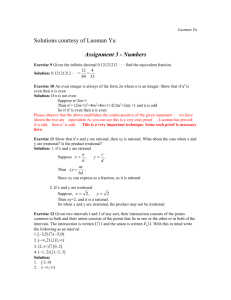Identifying Rational Numbers
advertisement

Illustrative Mathematics 8.NS Identifying Rational Numbers Task Decide whether each of the following numbers is rational or irrational. If it is rational, explain how you know. ⎯⎯ ⎯ a. 0.333 b. √4 ‾ c. √2 ‾ = 1.414213 … d. 1.414213 e. π = 3.141592 … f. 11 g. 17 ⎯⎯⎯⎯⎯⎯⎯⎯⎯⎯⎯⎯⎯⎯⎯⎯⎯⎯ = 0.142857 ⎯⎯⎯⎯⎯⎯ h. 12.3456565656 IM Commentary The task assumes that students are able to express a given repeating decimal as a fraction. Teachers looking for a task to fill in this background knowledge could consider the related task "8.NS Converting Decimal Representations of Rational Numbers to Fraction Representations ." Illustrative Mathematics There is a lot of interesting mathematics behind deciding questions about irrationality. There are a variety of arguments demonstrating that √2 ‾ is irrational (some of which would be quite accessible to a motivated middle school student), the first of which were discovered somewhere around the 5th century BC. And yet the irrationality of π was not proven until 1761, over two millenia later! Students who complete the task will probably be very close to being able to articulate the statement that a number is rational if and only if its decimal expansion is eventually periodic, in which case they could be posed problems like showing that the number 0.123456789101112131415161718192021.... is irrational. Note that even understanding the statement that √2 ‾ equals 1.414213 … is non-trivial, and partly addresses the part of the standard that says “Understand informally that every number has a decimal expansion." Solution a. Since ⎯⎯ ⎯ 0.333 = 1 3 ⎯⎯ ⎯ 0.333 is a rational number. b. Since √4‾ = 2 = 2 1 √4‾ is a rational number. c. √2 ‾ = 1.414213 … is not rational. In eighth grade most students know that the square root of a prime number is irrational as a "fact," but few 8th grade students will be able to prove it. There are arguments that 8th graders can understand if they are interested. d. Since 1.414213 = 1414213 , 100000 Illustrative Mathematics 1.414213 is a rational number. e. π = 3.141592 … is not rational. In eighth grade most students know that irrational as a "fact." The proof of this is quite sophisticated. π is f. Since 11 = 11 1 11 it is rational. g. 17 ⎯⎯⎯⎯⎯⎯⎯⎯⎯⎯⎯⎯⎯⎯⎯⎯⎯⎯ = 0.142857 is already written in a way that makes it clear it is a rational number, although some students might say it is irrational, possibly because the repeating part of the decimal is longer than many familiar repeating decimals (like 1 ). 3 h. We have ⎯⎯⎯⎯⎯⎯ ⎯⎯⎯⎯⎯⎯ 12.3456565656 = 12.34 + .0056 = 1234 56 1234 ⋅ 99 + 56 122222 + = = , 100 9900 9900 9900 which is certainly rational. 8.NS Identifying Rational Numbers is licensed by Illustrative Mathematics under a Creative Commons Attribution-NonCommercial-ShareAlike 4.0 International License








